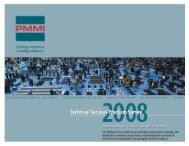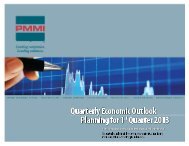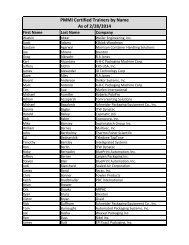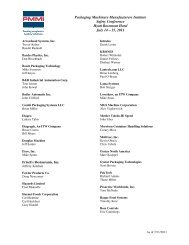Canadian Packaging Machinery Market Research Report - PMMI
Canadian Packaging Machinery Market Research Report - PMMI
Canadian Packaging Machinery Market Research Report - PMMI
You also want an ePaper? Increase the reach of your titles
YUMPU automatically turns print PDFs into web optimized ePapers that Google loves.
Table 1.4: <strong>Canadian</strong> Merchandise Trade 2002: Export Destinations and Import<br />
Sources<br />
Country<br />
Exports Imports<br />
C$ Millions Percent C$ Millions Percent<br />
United States $348,383.7 84.8 $254,688.3 71.5<br />
Japan 9,706.9 2.4 11,735.6 3.3<br />
United Kingdom 5,905.8 1.4 10,311.0 2.9<br />
Other European<br />
Economic Community<br />
Countries<br />
15,304.6 3.7 25,833.5 7.3<br />
Other OECD Countries 11,026.6 2.7 19,480.6 5.5<br />
Other Countries 20,359.0 5.0 34,060.4 9.6<br />
Total Merchandise<br />
Trade<br />
Source: Statistics Canada<br />
$410,686.5 100.0 $356,109.3 100.0<br />
1.5 POLITICAL/ECONOMIC ISSUES<br />
Canada is a politically stable nation, although it is currently undergoing a change in<br />
the leadership of the political party that governs Canada. By early 2004, Prime<br />
Minister Jean Chretien, leader of the Federal Liberal Party, will, in all likelihood, be<br />
replaced as leader of the party by Paul Martin. This leadership change will make Mr.<br />
Martin Canada’s next Prime Minister.<br />
For the past four decades Canada has been faced with a substantial portion of the<br />
Province of Quebec’s population who want to separate from Canada. However, the<br />
threat of Quebec’s succession from Canada has been substantially reduced as a<br />
result of the last Quebec provincial election. In April 2003, the Provincial Liberal<br />
Party, led by Jean Charet, defeated the Parti Québécois, a party that pursued a<br />
separatist agenda.<br />
For Canada, 2002 marked the eleventh consecutive year of economic growth. Real<br />
gross domestic product (GDP) increased at an annual rate of 2.4 per cent in the first<br />
quarter of 2003, a faster pace than the 1.6 per cent it experienced during the fourth<br />
quarter of 2002. But as a whole, real GDP grew 3.4 per cent in 2002, which was<br />
more than double the rate of 2001, and higher than the 2.4 per cent growth posted in<br />
the United States. In 2002, Canada attained the best performance amongst the G-8<br />
group of developed nations in terms of output growth and job creation. Even though<br />
short-term economic prospects remain vulnerable to certain impacts, such as Middle<br />
East uncertainty, SARS, and Mad Cow disease, most analysts expect continued<br />
growth in 2003. Canada is expected to lead the G-8 in terms of output as growth is<br />
forecast to reach 2.2 per cent in 2003. The Royal Bank of Canada predicts that the<br />
<strong>Canadian</strong> economy will see growth of 3.4 per cent in 2004.<br />
The foundation upon which Canada’s economic performance was built in 2002 was<br />
the consumer, as employment growth and pent-up demand for durables drove the<br />
SMG/Columbia Consulting Group Page 7
















